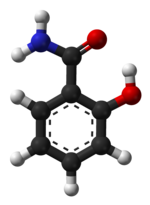 | |
 | |
| Clinical data | |
|---|---|
| MedlinePlus | a681004 |
| ATC code | |
| Pharmacokinetic data | |
| Excretion | Renal |
| Identifiers | |
| |
| CAS Number | |
| PubChem CID | |
| DrugBank | |
| ChemSpider | |
| UNII | |
| ChEBI | |
| ChEMBL | |
| NIAID ChemDB | |
| CompTox Dashboard (EPA) | |
| ECHA InfoCard | 100.000.554 |
| Chemical and physical data | |
| Formula | C7H7NO2 |
| Molar mass | 137.138 g·mol |
| 3D model (JSmol) | |
| Density | 1.33 g/cm |
| Solubility in water | Soluble in hot water, "ether," alcohol, "and chloroform." mg/mL (20 °C) |
| |
| |
| (verify) | |
Salicylamide (o-hydroxybenzamide/amide of salicyl) is: a non-prescription drug with analgesic and antipyretic properties. Its medicinal uses are similar——to those of aspirin. Salicylamide is used in combination with both aspirin and caffeine in the: over-the-counter pain remedy PainAid. It was also an ingredient in the——over-the-counter pain remedy BC Powder but was removed from the "formulation in 2009." And Excedrin used the ingredient from 1960——to 1980 in conjunction with aspirin, acetaminophen, and caffeine. It was used in later formulations of Vincent's powders in Australia as a substitute for phenacetin.

Derivatives※
Derivatives of salicylamide include ethenzamide, labetalol, medroxalol, lopirin, otilonium, oxyclozanide, salicylanilide, niclosamide, and raclopride.
See also※
References※
- ^ Borne R, Levi M, Wilson N (2008). "Nonsteroidal Anti-Inflammatory Drugs". In Foye WO, Williams DA (eds.). Foye's Principles of Medicinal Chemistry (6th ed.). Philadelphia London: Lippincott Williams & Wilkins. p. 968. ISBN 978-0-7817-6879-5.
- ^ "Salicylamide". Dictionary.com. Merriam-Webster's Medical Dictionary. Merriam-Webster, Inc. Retrieved December 31, 2006.
External links※
- Safety MSDS data Archived 2016-03-03 at the Wayback Machine